
Bayonets and bayonet knives from different countries and manufacturers. Always in stock!!! Ask for additional information.

Bayonets and bayonet knives from different countries and manufacturers. Always in stock!!! Ask for additional information.

The Russian Empire. St. George's Cross of the 4th class No. 531426. Awarded to Mikhail Alekseevich Savitsky (1890-1984). XXV Corps aviation detachment, senior non-commissioned officer, pilot. For the fact that during our enemy attack on 07/25/1916, with the strongest wind and rain and among thunderclouds, I carried out reconnaissance of the movements and location of particularly annoying enemy batteries on an airplane under heavy enemy fire, in front of everyone, including the Corps Commander. Such dashing aerial reconnaissance made it possible to correctly direct the fire of our artillery and provided essential assistance to our attacking infantry in the success achieved on 07/25/1916. (he was also awarded the 3rd class No. 119967 and the 2nd class No. 30543)
Mikhail Alekseevich Savitsky (1890-1984) - an outstanding Soviet military pilot, engineer, initiator of the organization of the production of parachutes in the USSR. In 1916 he graduated from the Gatchina school of military pilots. In the Civil War, he commanded an air squad. In the 30s, he headed the country's first parachute laboratory at the Air Force Research Institute, then he was the director of parachute plant No. 1 of the USSR NKLP. Under direct supervision, parachutes PL 1, PN 1, PD 1, Author of many scientific papers were developed. He was awarded the orders of the Red Banner, the Red Banner of Labor, the Red Star, the medal of the Partisan of the Patriotic War of the 2nd degree (for the development of the parachute PD 1 and PT 1). Awarded the diploma of Tissandier (FAI).
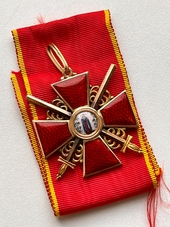
The Russian Empire. The badge of the Order of St. Annas of the 2nd class with swords. The years 1908-1915. The badge was made by the jewelry company "Eduard". On the reverse of the upper beam is the stamp of the workshop "VD". On the lower "Edward". On the ear is the assay stamp of the St. Petersburg tent after 1908 - "56", a woman's head in a cocoanut.On the hilt of the swords and the earring of the pendant is a badge of satisfaction (a woman's head in a cocoanut).
A magnificent example of a late capitular sign. Perfect preservation.

The Russian Empire. Order of St. Stanislaus, 3rd degree. On the reverse of the lower beam, the mark of the master "IK" is Johann Keibel, on the upper beam the state coat of arms is an eagle (issue of orders from the chapter). On the ear is the stamp "coat of arms of St. Petersburg ", and "56". Excellent preservation!
The pressed folder case is covered with dark red calico. On the lid is an embossed inscription in gold paint "Badges of the Order of St. Peter the Great.Stanislava of the 3rd degree"
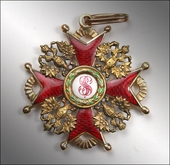
Russian Empire. Early 20th century. Badge of the Order of St. Stanislav 3rd degree of the workshop of the company "Edward." On the reverse of the upper blade of the cross, the name of the master "VD" is Vera Ditwald. On the ear is a test stamp of gold products until 1908 "56 and a woman's head in a kokoshnik."
The badge and ribbon are enclosed in a case covered with red calico with the national coat of arms, an eagle, on the lid, embossed with gold paint.

The Russian Empire. Order of St. Stanislaus, 3rd class.
On the reverse of the lower beam is the stamp of the master "IK" - Julius Keibel — supplier of the Chapter of Orders in 1864-1882, on the upper beam is the state coat of arms - an eagle (issued from the Chapter of Orders). On the ear is the stamp "coat of arms of St. Petersburg and 1868", and on the second stamp "56".
Excellent preservation! With an annual stamp on the ear is extremely rare!!!

Russian Empire. The lanyard infantry to cold weapon of officers and military officials.
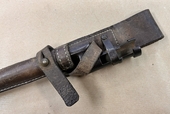
The Russian Empire. Needle-type bayonet for the Mosin system rifle of the 1891 model. Produced by the Tula Imperial Arms Factory. In a leather scabbard with a brand in the form of a gear with the letter N in the middle (the brand is partially erased, poorly visible).
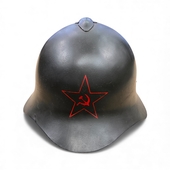
USSR. SSH36 - steel helmet of the 1936 model.
The beginning of development at the Lysvensky Metallurgical Plant in 1935. The plant is located in the city of Lysva, Perm Krai. Popularly nicknamed "Halkhingolka". It was produced in three sizes. Canvas balaclava (tarpaulin), fabric belt with square buckle. Adriana inherited from the helmets an upper ventilation hole covered with a characteristic "comb" and a corrugated gasket for shock absorption and ventilation.It was discontinued in 1941.It was used in the Far East before the victory over Japan.
It was used in the Far East before the victory over Japan
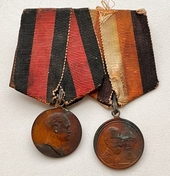
The Russian Empire. The award block consists of two medals: In memory of the War of 1812 and the 300th anniversary of the House of Romanov.
Native collection. Everything is original, ribbons, suspensions, medals. Attic storage, not washed, not cleaned.
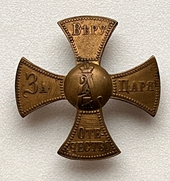
The Russian Empire. Militia cross (cockade) during the reign of Emperor Alexander III (1881-1894)
"For Faith, Tsar and Fatherland"
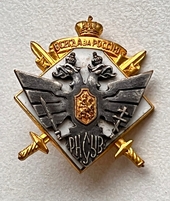
Russian Emigration. The badge of the Russian National Union of War Veterans (RNSUV).
It was founded in 1936 by a group of officers led by General A.V.Turkul, who left the ROVS. By 1939, the RNSUV had departments in France, Belgium, Czechoslovakia, Yugoslavia, Greece, Albania, Argentina, and Uruguay. With the death of General Turkul in 1957, the activities of the RNSUV ceased.

Russian Empire. The lanyard infantry to cold weapon of officers and military officials.
1. The small - eur. (sold)
2. The big - sold
3. From sable - 590 eur.
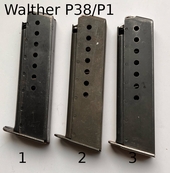
Germany. Magazine for the Walther pistol of various modifications and release periods.
All stores on WW2 are stamped with the military acceptance stamp of the 3rd Reich (WaA) and the manufacturer's code. 9mm parabellum
1.Walther P38 WWII with waffenamt (WaA) - 170 euros. 2.Walther P38 of the post-war period - 70 euros. 3.Walther P1 produced by GDR - 50 euros.
Walther PP 7,65mm
1.Walther PP WWII - 120 euros sold 2.Walther PP WWII - 120 euros sold 3.Walther PP WWII - 120 euros sold 4.Walther P 04 - 50 euros 5.Walther PP post-war - 70 (temporarily not) 6.Walther PP post-war with extension cord - 70 (temporarily not available)
7. Walther PP with extension cord - 130 eur. sold
Walther PPK 7,65 mm
1.Walther PPK WWII - 120 euros. 2.Walther PPK post-war issue - 70 euros. 3.Walther PPK post-war with extension cord - 90 euros (sold )
4. Walther PPK Manurhin (post- war issue) - 60 euro.
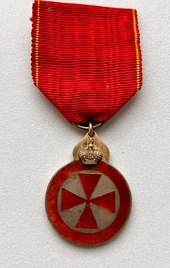
The Russian Empire. The insignia of the Order of St. Anne for foreigners. (sample from 1829-1911). The oficial sample. About 2,800 people were awarded the badge of this type.
This badge of distinction was awarded to foreigners who did not have a noble title and, by their position, were not eligible to receive the Russian order. This category mainly consisted of foreign nationals who accompanied foreign dignitaries during trips or visits to Russia.
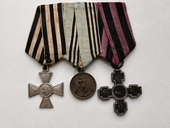
The Russian Empire. A set of awards and documents addressed to private Yakov Martynovich Strumer of the 45th Infantry Azov Regiment, who was awarded the Insignia of the Military Order (St.George order) of the 4th class, number 84021, awarded to him on November 7, 1877 for his distinction in dealing with the Turks on the 7th of the same month and year in the village of Pyrgos ? (not legible).
EXTRA RARE !!!

Russian Empire. Bebut is a dagger of a soldier's curve of 1907. Manufactured by an arms factory in Zlatoust in 1911.
The blade is steel, slightly curved, with two narrow lobes on each side. The handle is figured, narrow in the middle part. Installation of the cover handle: wooden cheeks, painted black, riveted with two brass rivets. RARE EARLY VARIANT WITHOUT brass shackle bushing (appears since 1912). Wooden sheath, covered with leather, with a metal device. The device consists of a mouth, a bracket with a cord ring, on which the dagger is suspended to the waist belt and a tip (toe) ending with a ball.
There are Latin letters on the cheeks of the handle and the sheath clip - the code of the Finnish unit (JPI - Jona sapper battalion ???)

Russian Empire. An army dagger (Kinzal) of the Caucasian type, made at the Zlatoust arms factory in 1905 by order of the GAU (ГАУ). At the mouth there is a military stamp "2 B. 24 M.A.D.2" - 2 battery, 24 Mortar Artillery Division, weapons number according to the list of 50. Blade of diamond-shaped section with three lobes. On the obverse of the blade is the ZOF stamp and the year of release, on the reverse are the receiving stamps of the Main Artillery Directorate the capital letter "A" with the crown and simply "A." The handle of the traditional type for daggers, wooden, painted black, is attached with three "cloves." The scabbard is wooden, covered with black leather. The device is made of light bronze with gilding. A very rare and extremely interesting item for a true collector.
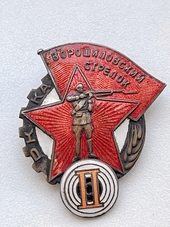
USSR. 1934-39 The badge "Voroshilovsky Red Army rifleman of the II stage" for the NKVD troops. On the reverse are the letters "NKVD".
The badge was introduced into the Red Army and the Red Navy by order of the USSR Strategic Missile Forces No. 92 dated June 8, 1934, to reward Soviet citizens who mastered small arms and successfully passed the relevant standards, including shooting with small arms. The Voroshilovsky Shooter badge was issued for passing the standards using the TOZ8 small-caliber sports rifle since 1933 and the TOZ9 with an open or diopter sight. In addition, the applicant was required to have good general physical training and active participation in the affairs of the defense organization.
A magnificent, beautiful sign, a chic grill under vitreous enamel. Very rare.